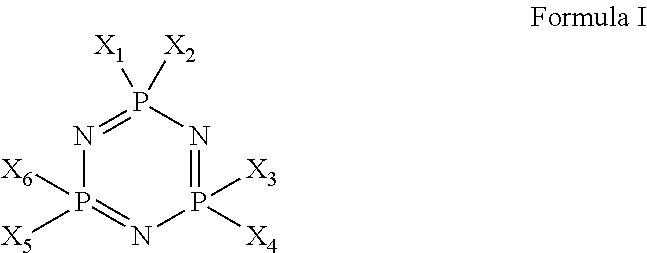Siloxane-modified cyclotriphosphazene halogen-free flame retardant, preparation process and use thereof
a technology of cyclotriphosphazene and cyclotriphosphazene, which is applied in the field of siloxane-modified cyclotriphosphazene halogen-free flame retardant, can solve the problems of high water absorption, high dissolving property of such flame retardants, and many troublesome subsequent processing, and achieve excellent flame retardant efficiency, good thermal stability, and high char formation rate
- Summary
- Abstract
- Description
- Claims
- Application Information
AI Technical Summary
Benefits of technology
Problems solved by technology
Method used
Image
Examples
example 1
[0073](1) The cyclotriphosphazene compound DOPO-HAP containing DOPO having the following structure was synthesized according to the document (Qian, L., et al. (2011). “The non-halogen flame retardant epoxy resin based on a novel compound with phosphaphenanthrene and cyclotriphosphazene double functional groups.”Polymer Degradation and Stability 96(6): 1118-1124)
[0074]According to the reference document above, the synthetic method is stated as follows.
[0075]Into a four-necked flask equipped with a thermometer, a nitrogen inlet tube, a magnet, and a reflux condenser were added 34.8 g of cyclotriphosphazene, 85.6 g of p-hydroxybenzaldehyde and 75 g of sodium carbonate. Then 600 mL of tetrahydrofuran was added, and nitrogen was fed to heat to 60° C. and react for 28 h while stirring. After cooling, the by-product salt and residual sodium carbonate were filtered to remove. The filtrate was subject to rotary evaporation to remove the solvent dioxane, to obtain a milky white solid. The afo...
example 2
[0079](1) The cyclotriphosphazene compound DOPO-HAP containing DOPO was prepared according to the same preparation process as stated in step (1) of Example 1.
[0080](2) The cyclotriphosphazene DOPO-HAP containing DOPO prepared in step (1) was dissolved in a DMF solvent, and nitrogen was added thereto. Siloxane monomer was added in a mass ratio of DOPO-HAP:KBM403 (Nippon Shin-Etsu Chemical Co., Ltd.) of 4:1, and a catalyst dibutyltin dilaurate was added in an amount of 0.3% by mass of the siloxane monomer. Deionized water was added in an amount equal to the molar number of siloxane-OCH3, and the reaction was carried out at 90° C. for 3 h. Then, the reaction mixture was heated to 110° C. for 6 h. After cooling, the viscous reaction product was introduced into ice-acetone to precipitate a white soft solid DHS-2 having the structure as shown in the following formula:
wherein six Rs are independently
or H (not all H).
[0081]The epoxy value of the solid product was determined by the acetone-h...
example 3
[0083](1) The cyclotriphosphazene compound DOPO-HAP containing DOPO was prepared according to the same preparation process as stated in step (1) of Example 1.
[0084](2) The cyclotriphosphazene DOPO-HAP containing DOPO prepared in step (1) was dissolved in a DMF solvent, and nitrogen was added thereto. Siloxane monomer was added in a mass ratio of DOPO-HAP:KBM903 (Nippon Shin-Etsu Chemical Co., Ltd.) of 3:1, and a catalyst cobalt acetylacetonate was added in an amount of 0.1% by mass of the siloxane monomer. Deionized water in an amount of 1.3 times of the molar number of siloxane-OCH3 was added, and the reaction was carried out at 75° C. for 7 h. Then, the reaction mixture was heated to 100° C. for 2 h. After cooling, the viscous reaction product was introduced into ice-acetone to precipitate a white soft solid DHS-3 having the structure as shown in the following formula:
wherein six Rs are independently
[0085]The amine value of the solid product DHS-3 was determined by the perchloric ...
PUM
| Property | Measurement | Unit |
|---|---|---|
| boiling point | aaaaa | aaaaa |
| boiling point | aaaaa | aaaaa |
| melting point | aaaaa | aaaaa |
Abstract
Description
Claims
Application Information
 Login to View More
Login to View More - R&D
- Intellectual Property
- Life Sciences
- Materials
- Tech Scout
- Unparalleled Data Quality
- Higher Quality Content
- 60% Fewer Hallucinations
Browse by: Latest US Patents, China's latest patents, Technical Efficacy Thesaurus, Application Domain, Technology Topic, Popular Technical Reports.
© 2025 PatSnap. All rights reserved.Legal|Privacy policy|Modern Slavery Act Transparency Statement|Sitemap|About US| Contact US: help@patsnap.com



